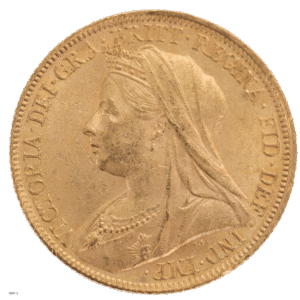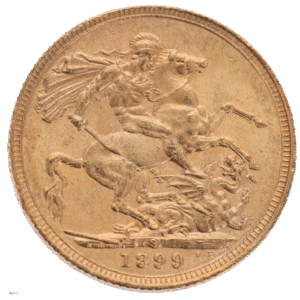The Queen Victoria Veiled Head Sovereign (also known as the “Old Head” Sovereign) represents the final sovereign design of Victoria’s remarkably long reign. Introduced in 1893, these dignified gold coins depict the aging monarch in her twilight years and circulated during the height of British imperial power. With their distinctive portrait showing Victoria wearing both a crown and widow’s veil, these sovereigns symbolise the culmination of the Victorian era that transformed Britain and shaped the modern world.
When the Veiled Head sovereigns were introduced in 1893, Queen Victoria had been on the throne for 56 years. This final period of her reign (1893-1901) coincided with significant historical developments:
- The peak of the British Empire, covering approximately one-fourth of the Earth’s total land area
- The Diamond Jubilee celebration of 1897, marking Victoria’s unprecedented 60 years on the throne
- Growing international tensions and imperial competition with Germany and Russia
- The Second Boer War (1899-1902), which would continue beyond Victoria’s death
- The emergence of new technologies like wireless communication, cinematography, and motorised transport
- The transition into the modern era of the 20th century
These coins represent the capstone of Victorian numismatics, bridging the 19th and 20th centuries during a period of both celebration and growing challenges to British imperial dominance.
The obverse features a new portrait of the elderly Queen Victoria designed by Sir Thomas Brock. This dignified portrayal shows:
- The aging queen facing left, with realistic features showing her 74 years
- A small diamond crown (as opposed to the imperial state crown)
- A widow’s veil draped behind, which she continued to wear in memory of Prince Albert, who had died in 1861
- The Order of the Garter and the Order of the Crown of India clearly visible
- The inscription “VICTORIA · DEI · GRA · BRITT · REGINA · FID · DEF · IND · IMP” (Victoria, by the Grace of God, Queen of Britain, Defender of the Faith, Empress of India)
This portrait represented a significant change from the Jubilee Head design it replaced, offering a more realistic and mature depiction of the queen.
The reverse features Benedetto Pistrucci’s classic St. George and dragon design that had become synonymous with the sovereign. This dynamic scene shows:
- St. George mounted on horseback
- The dragon beneath, being slain by St. George’s short sword
- The ground line below with the date
- Pistrucci’s initials “B.P.” in the exergue below the main design
- Various mint marks for coins produced outside London
FAQs
Queen Victoria Old Head Sovereigns, also known as Veiled Head coinage, were British coins struck between 1893 and 1901. They feature an aged Queen Victoria wearing a diadem and a widow’s veil. This coinage replaced the Jubilee coinage due to criticisms of the previous design and the lack of clear value indications on the coins.
You can explore and purchase these remarkable coins at Jaggards, a trusted source for high-quality numismatic treasures. Our experts curate authentic collections with a focus on historical significance and quality.
The most common reason for a change in the head on sovereign coins is a new monarch ascending to the throne. Each monarch has their portrait on the coinage to reflect the current ruler. As a result, when a new king or queen takes the throne, the coin design is updated to feature their likeness.
The Old Head sovereigns hold particular appeal for collectors for several reasons:
- They represent the final sovereign design of Britain’s longest-reigning monarch until Elizabeth II
- The portrait captures Victoria as most contemporaries would have known her
- They were produced at multiple mints, creating diverse collecting opportunities
- The overlapping Diamond Jubilee of 1897 adds historical interest
- Their production spans the transition from the 19th to the 20th century
- They connect to the height of British imperial power

